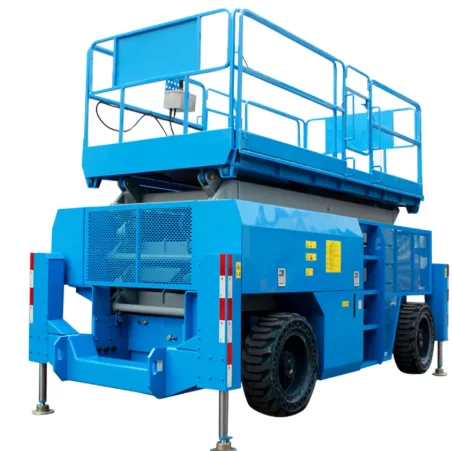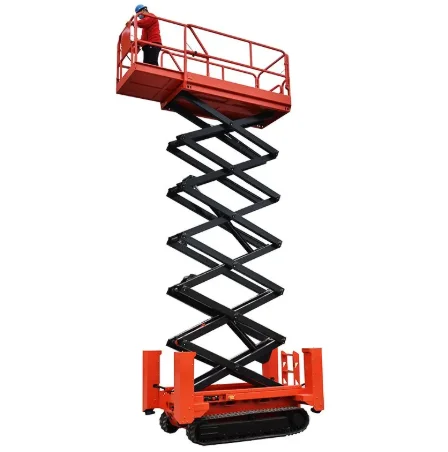How to Move Scissor Lifts Without Damage or Delay
How to Move Scissor Lifts Without Damage or Delay
Moving a scissor lift from one jobsite to another sounds simple—until you’ve seen a damaged platform sitting on the back of a truck because someone skipped a step. Whether it’s a mini lift rolling through a shopping mall entrance or a heavy all-terrain unit being hauled to a construction site, transportation mistakes can cost serious money and time. Let’s walk through the main questions contractors and equipment managers usually ask when planning to transport scissor lifts safely.
What Are the Main Risks During Scissor Lift Transport
Equipment damage from poor loading
The most common incident is a bent guardrail or a cracked platform floor. This often happens when the machine is pushed up a ramp without checking the slope angle. Scissor lifts, especially larger all-terrain models, are heavy. A 15-meter diesel lift from YILU LIFT weighs several tons. If it tilts while loading, repairing hydraulic or frame damage will be far more expensive than hiring the right truck in the first place.

Safety hazards during transit
Loose chains or straps can turn a secure lift into a rolling hazard. There have been cases where lifts shifted on highways, causing near accidents. Even small mini lifts under 1 ton need certified tie-downs, not just casual ropes. Drivers and workers both face risk if this part is ignored.
Costly downtime from improper handling
Delays are not just about hours lost. If a crawler scissor lift meant for uneven terrain doesn’t arrive on time, a team of ten workers might stand idle at a site. In some regions, downtime penalties are written into contracts. A single day of delay can eat into the margin of a project.
How Should Scissor Lifts Be Prepared Before Moving
Pre-transport inspection checklist
Before a lift moves, a simple checklist helps. Operators should fold down guardrails, retract the extension platform, and check for any loose tools left on deck. Hydraulic oil leaks, tire pressure, and battery charge are small details but prevent bigger issues later. YILU LIFT machines come with quick diagnostic displays, which makes this step faster.
Battery and hydraulic system preparation
For electric mini lifts, batteries should be topped off and the key switch removed before loading. On diesel all-terrain models, fuel tanks need to be closed tightly, and engines cooled down before transport. Hydraulic systems must be checked for leaks—nothing worse than unloading a machine with oil dripping.
Securing platforms and safety rails
Platforms should be fully lowered. It may sound obvious, but more than one contractor has tried to move a lift with the deck half-raised. Foldable rails, like on YILU’s mini electric lifts, are designed exactly for transport, cutting overall height so they fit in standard trucks or containers.
Which Transport Methods Work Best for Different Scissor Lift Types
Flatbed trucks for standard models
Flatbeds remain the most practical option for medium-size lifts. Their wide decks and sturdy loading ramps make them suitable for most urban deliveries. A standard 10-meter unit can be tied down quickly and offloaded without special permits.
Trailers with ramps for mini scissor lifts
Compact electric lifts, like YILU’s 3-7m mini series, are light enough to be wheeled onto trailers with simple metal ramps. These units weigh under a ton, which means a pickup and trailer combo is often enough. For indoor projects—airports, shopping centers, even hotels—this ease of transport is a huge plus.
Heavy-duty carriers for rough terrain and crawler lifts
Crawler lifts with tracks require specialized carriers, often low-bed trailers with reinforced loading capacity. Their tracked undercarriage is great on mud and gravel, but tricky for normal ramps. Logistics partners familiar with construction machinery transport should handle these, especially for long hauls across provinces or international shipping.
Why Choose All Terrain Scissor Lifts for Outdoor Projects
Strong climbing ability and stability on slopes
All terrain scissor lifts aren’t just bigger—they’re designed to climb. YILU’s diesel-powered models can tackle slopes up to 25%. On a hillside project where other machines stall, that stability means fewer headaches.
Diesel power for extended outdoor use
Diesel scissor lifts keep running longer without charging breaks. They’re suited for construction zones where electricity isn’t always available. Contractors often mention how valuable that is when deadlines are tight.
Flexible working heights from 12m to 18m
With working ranges from 12 to 18 meters, one lift covers multiple job types. A crew doing façade repairs at 12m today may need 18m tomorrow for roof work. Instead of switching equipment, the same unit adapts, reducing fleet costs.
How Do Mini Scissor Lifts Simplify Indoor Transport
Compact body for narrow passages
These units are built for tight corridors. At just 760mm wide, YILU’s mini lifts fit through standard doorways without dismantling. One contractor joked that moving them through hotel lobbies is easier than moving a piano.
Full electric drive with low noise
Noise restrictions are common in shopping malls or office towers. Electric drive systems run quietly, which keeps property managers happy. They also eliminate exhaust fumes—no need to worry about ventilation indoors.
Easy loading with lightweight design
At under 800kg, mini lifts can be loaded by two workers using portable ramps. This portability saves on heavy transport costs and allows small teams to manage logistics themselves.
When Is a Crawler Scissor Lift the Better Choice
Superior traction on uneven ground
Tracked scissor lifts spread weight evenly, making them stable even on soft soil. They’re often chosen for landscaping or unfinished construction sites where wheels sink.
Wide application across construction and shopping centers
Surprisingly, crawler lifts aren’t limited to muddy fields. Their maneuverability also helps in large shopping centers during renovation projects, moving smoothly across tiles without damaging surfaces.

Reliable hydraulic system with stable lifting
YILU crawler lifts use high-strength manganese steel frames and robust hydraulic drives. This ensures steady platform movement, even with full load. In industries where vibration-sensitive work is done—like electrical installations—this stability matters.
What Are the Best Practices to Prevent Transport Delays
Partnering with experienced logistics providers
Not every trucker understands scissor lifts. Work with carriers who move aerial platforms regularly. They’ll know about weight distribution, tie-down points, and local transport rules.
Using certified tie-down equipment
Always use rated chains and ratchet straps. A strap breaking on the highway can mean not just damage but liability. Spending a few extra dollars on certified gear is cheap insurance.
Planning routes with site conditions in mind
A flatbed may not reach a hillside villa project. In some cities, road permits for oversized loads are only valid at night. Planning routes and timing prevents unnecessary waiting. It sounds boring, but it avoids phone calls at 6am asking why the lift hasn’t arrived.
FAQs
Q1. Can scissor lifts be shipped overseas easily?
A: Yes, many scissor lifts including YILU models are designed to fit standard shipping containers. Foldable rails reduce overall height, making sea freight more practical.
Q2. Do crawler scissor lifts damage indoor floors?
A: Not usually. Modern crawler lifts use rubber tracks designed to minimize surface impact. Still, for delicate tiles or polished floors, protective mats are recommended.
Q3. How long does it take to load a mini scissor lift?
A: With the right trailer and ramps, loading a YILU mini lift takes about 10–15 minutes. The lightweight design makes the process quick and manageable, even for small teams.




